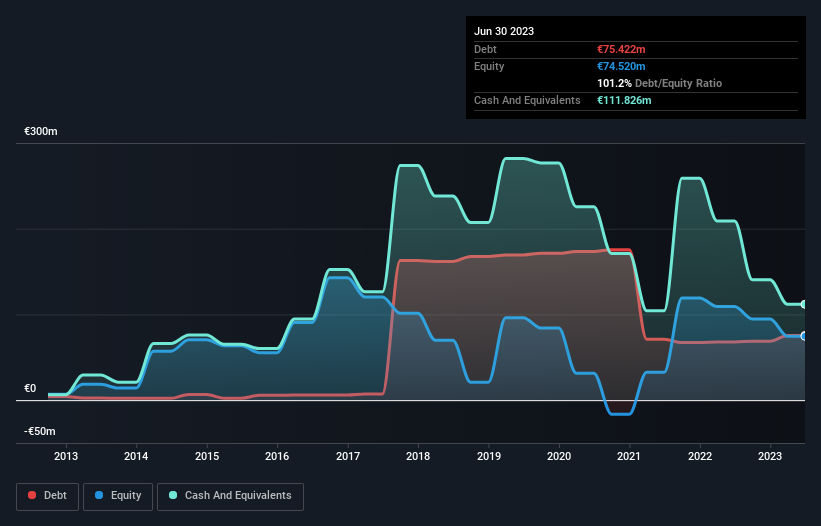Health Check: How Prudently Does Genfit (EPA:GNFT) Use Debt?
David Iben put it well when he said, 'Volatility is not a risk we care about. What we care about is avoiding the permanent loss of capital.' So it might be obvious that you need to consider debt, when you think about how risky any given stock is, because too much debt can sink a company. As with many other companies Genfit S.A. (EPA:GNFT) makes use of debt. But should shareholders be worried about its use of debt?
What Risk Does Debt Bring?
Generally speaking, debt only becomes a real problem when a company can't easily pay it off, either by raising capital or with its own cash flow. Ultimately, if the company can't fulfill its legal obligations to repay debt, shareholders could walk away with nothing. While that is not too common, we often do see indebted companies permanently diluting shareholders because lenders force them to raise capital at a distressed price. Having said that, the most common situation is where a company manages its debt reasonably well - and to its own advantage. When we think about a company's use of debt, we first look at cash and debt together.
Check out our latest analysis for Genfit
How Much Debt Does Genfit Carry?
You can click the graphic below for the historical numbers, but it shows that as of June 2023 Genfit had €75.4m of debt, an increase on €68.0m, over one year. However, it does have €111.8m in cash offsetting this, leading to net cash of €36.4m.

How Strong Is Genfit's Balance Sheet?
The latest balance sheet data shows that Genfit had liabilities of €45.7m due within a year, and liabilities of €73.7m falling due after that. Offsetting these obligations, it had cash of €111.8m as well as receivables valued at €20.2m due within 12 months. So it actually has €12.6m more liquid assets than total liabilities.
This surplus suggests that Genfit has a conservative balance sheet, and could probably eliminate its debt without much difficulty. Succinctly put, Genfit boasts net cash, so it's fair to say it does not have a heavy debt load! There's no doubt that we learn most about debt from the balance sheet. But it is future earnings, more than anything, that will determine Genfit's ability to maintain a healthy balance sheet going forward. So if you want to see what the professionals think, you might find this free report on analyst profit forecasts to be interesting.
Over 12 months, Genfit made a loss at the EBIT level, and saw its revenue drop to €29m, which is a fall of 69%. To be frank that doesn't bode well.
So How Risky Is Genfit?
By their very nature companies that are losing money are more risky than those with a long history of profitability. And the fact is that over the last twelve months Genfit lost money at the earnings before interest and tax (EBIT) line. And over the same period it saw negative free cash outflow of €52m and booked a €34m accounting loss. But the saving grace is the €36.4m on the balance sheet. That kitty means the company can keep spending for growth for at least two years, at current rates. Even though its balance sheet seems sufficiently liquid, debt always makes us a little nervous if a company doesn't produce free cash flow regularly. When analysing debt levels, the balance sheet is the obvious place to start. But ultimately, every company can contain risks that exist outside of the balance sheet. Be aware that Genfit is showing 2 warning signs in our investment analysis , you should know about...
When all is said and done, sometimes its easier to focus on companies that don't even need debt. Readers can access a list of growth stocks with zero net debt 100% free, right now.
New: Manage All Your Stock Portfolios in One Place
We've created the ultimate portfolio companion for stock investors, and it's free.
• Connect an unlimited number of Portfolios and see your total in one currency
• Be alerted to new Warning Signs or Risks via email or mobile
• Track the Fair Value of your stocks
Have feedback on this article? Concerned about the content? Get in touch with us directly. Alternatively, email editorial-team (at) simplywallst.com.
This article by Simply Wall St is general in nature. We provide commentary based on historical data and analyst forecasts only using an unbiased methodology and our articles are not intended to be financial advice. It does not constitute a recommendation to buy or sell any stock, and does not take account of your objectives, or your financial situation. We aim to bring you long-term focused analysis driven by fundamental data. Note that our analysis may not factor in the latest price-sensitive company announcements or qualitative material. Simply Wall St has no position in any stocks mentioned.
About ENXTPA:GNFT
Genfit
A late-stage biopharmaceutical company, discovers and develops drug candidates and diagnostic solutions for metabolic and liver-related diseases.
Adequate balance sheet and fair value.
Similar Companies
Market Insights
Community Narratives




